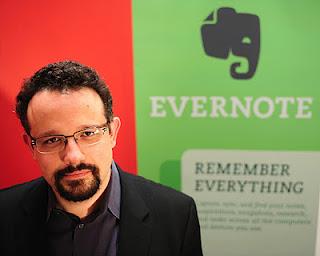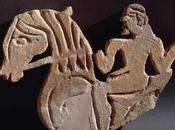Evernote è nata nel 2007 dalla fusione di due squadre distinte: la prima, guidata da Stepan Pachikov, che si occupava di memory capture e riconoscimento di immagini in California, e quella di Phil Libin, che faceva ricerca su argomenti simili a Boston. I due hanno quindi deciso di unire le due squadre, e il primo prodotto Evernote è stato reso disponibile al pubblico nel 2008. [video]
Sicuramente ci saranno nuove integrazioni e funzionalità di Evernote in futuro: la visione è quella di creare un cervello esterno, a cui affidare qualsiasi tipo di ricordo, per tutta la vita. Per questo motivo è stato pensato come strumento cross-platform, in modo che funzioni su qualsiasi browser, piattaforma, gadget, telefono o computer una persona possa usare.
Sono in via di sviluppo anche integrazioni più agevoli per i calendari e le to-do list. [video]
L'obiettivo di Evernote è di rendere le persone più produttive grazie a un "secondo cervello", aspetto che costituisce il core service, ma che prevede molte modalità per inserire e recuperare le informazioni. Alcune app sono sviluppate direttamente da Evernote, altre da terze parti, ma con Evernote Hello ed Evernote Food è diventato ancora più evidente che lo scopo è di fornire un'esperienza straordinaria di utilizzo, a prescindere dall'ambito. [video]
 La ricerca sulla ricognizione di immagini era il core della squadra di Stepan, che negli anni '80 - '90 ha lavorato alle feature di ricognizione dello scritto a mano per Apple Newton, il primo palmare per come vengono definiti oggi . Il concetto che ci sta dietro è molto semplice: la maggior parte dei nostri ricordi sono visivi per natura, quindi la parte di ricerca più consistente in questo momento è concentrata sulla ricerca di parole dentro le immagini. I server di Evernote elaborano le immagini e applicano diversi algoritmi per il riconoscimento di lettere e parole e per l'individuazione della lingua.
La ricerca sulla ricognizione di immagini era il core della squadra di Stepan, che negli anni '80 - '90 ha lavorato alle feature di ricognizione dello scritto a mano per Apple Newton, il primo palmare per come vengono definiti oggi . Il concetto che ci sta dietro è molto semplice: la maggior parte dei nostri ricordi sono visivi per natura, quindi la parte di ricerca più consistente in questo momento è concentrata sulla ricerca di parole dentro le immagini. I server di Evernote elaborano le immagini e applicano diversi algoritmi per il riconoscimento di lettere e parole e per l'individuazione della lingua.Le immagini vengono quindi indicizzate per la ricerca, combinando le informazioni sul testo contenuto a informazioni aggiuntive sulla location, data e ora, e creando un rich index che permette di contestualizzare qualsiasi informazione venga affidata a Evernote. [video]
Il prodotto conta 22 milioni di utenti in tutto il mondo, più del doppio rispetto a soli sei mesi fa: attualmente infatti Evernote guadagna 60.000 nuovi utenti al giorno. L'azienda inoltre ha circa 9.000 developer esterni che sviluppano app che si integrano con il prodotto Evernote. [video]
Le prospettive per il futuro sono difficili da definire, se non per il breve termine. Phil ci ha detto con certezza, però, che uno degli obiettivi più importanti per il 2012 sarà l'espansione in Europa dato che nel 2011 ci si è concentrati maggiormente sui mercati asiatici. Sarà cruciale capire quali sono le partnership possibili e quali le necessità degli utenti europei, considerando anche il fatto che, nonostante sia disponibile solamente da due mesi sul mercato europeo, questo rappresenta nel suo complesso il mercato più grande di Evernote. [video]
Recentemente è stato inaugurato anche l'ufficio europeo di Evernote, con sede a Zurigo, con un focus molto marcato sul product development. Lo scopo è di sviluppare parti di Evernote in diversi posti nel mondo, in modo tale da combinare le migliori capacità e idee che si possano trovare.
In Europa stanno quindi stipulando diverse partnership, la prima delle quali è con Orange - France, e cercando collaborazioni con developer europei. [video]
Invito tutti a visionare l'intervista integrale, molto più ricca di dettagli e insight rispetto a questa mia breve sintesi.
Buona visione!
Maria Petrescu
StartupID | Phil Libin of Evernote
This interview for StartupID is with Phil Libin, CEO of Evernote, a multiplatform note taking app which was designed specifically for mobile devices.
Evernote was born in 2007 from the fusion of two teams: the first, led by Stepan Pachikov, which was doing research on memory capture and handwriting recognition in California, and the second, led by Phil Libin, that was doing research on similar concepts in Boston. They met and decided to unite the two teams in 2007, and the first ever Evernote product was launched in 2008. [video]
There will most certainly be new integrations and functions of Evernote in the future: the vision is to create an external brain, where you can store any kind of memory for life. This is the reason why it has been designed to be cross-platform, so that it will work on any browser, platform, gadget, phone or computer you have. Some new integrations for calendaring and todo lists are being developed during these weeks. [video]
Evernote's goal is to make people more productive thanks to a second brain, which is the core service, but it has a lot different ways to get information in and out of it. Some apps are developed directly by Evernote, other by third party developers, but with Evernote Hello and Evernote Food it has become even more evident that the aim is to provide a unique use experience, regardless of the context. [video]
The research on image recognition was Stepan's team's core, the same team that in the '80s and 90's has worked on the handwriting recognition feature for the Apple Newton, which was the first ever tablet. The concept is very simple: most of our memories are visual in nature, so the most important part of the research is how to find text inside images. Evernote's servers elaborate the images and apply different algorythms for the recognition of letters, words, and the language itself.
The images are then indexed for research, combining information about the text inside them with additional info about location, date and time, creating a rich index that allows you to have context for any information stored in Evernote. [video]
The product has 22 milion users around the world, more than double than 6 months ago: Evernote is getting 60.000 new users a day. The company has 9.000 external developers that work on apps that integrate with Evernote. [video]
The perspectives for the future are hard to define, if not for the short term. Phil told us that the most important goal for 2012 will be spreading in Europe, considering that in 2011 they have concentrated more on the Asian market. It will be crucial to understand what the possible partnerships and European users' needs are, also because considering the incredible growth of the past two months, Europe as a whole is Evernote's biggest market. [video]
Evernote's European office in Zurich has been recently opened, and they are focused on product development. The goal is to develop different parts of Evernote in different parts of the world, so that they can get the best ideas and the best designs possible. They are already working on several partnerships in Europe, the first of which has been announced just a few days ago and is with Orange - France, but other collaborations of this kind are on their way. They are also looking for European developers to collaborate with. [video]
I invite everyone to view the full interview, much richer in detail and insight than my brief synthesis.
Enjoy!
Maria Petrescu







